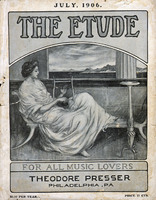NEITHER the young teachers nor the inexperienced pupil-should be tempted from the study of the mellifluous measures of Mozart and Mendelssohn to the more intense and involved compositions of the later psychological writers of mood and passion. Sunshine is as vital to art as gloom; joyousness, as sadness; gladness, as grief. One may sneer at the alleged “shallowness” of Mozart and the formal elegance of Mendelssohn—and these composers here represent the whole school of writers of this style—but they help to maintain the balance and to restrain the art from toppling over into psychic disquisitions and gloomy ponderosities.
There is a certain style of musician—and no one questions his erudition—who is prone to regard with only half-concealed disdain the music that is not tragic, tense and involved. Such serious minded individuals seem to lose sight of the fact that the sunshine of joy is the positive element of music, not the gloom of sadness. There must be smiles as well as tears and smiling optimism has accomplished more in the art world than gloomy seriousness.
It was given to Mozart and Mendelssohn to pen life and love into their works. They were not apostles of pessimism. They did not revel in the depths of cavernous gloom as have many of their successors; they taught happiness, wholesome thought, the “joy of living,” through their music.
This being true, and who can gainsay it, it follows that the music of these, clean-hearted, light-hearted writers is the best for the days of youth. Sadness, worry, complications—all these come only too soon into the young life; why drag them in by the musical route? Youth has no sympathy with any of them, nor will it take kindly to music of this character. Youth is a time of sunshine; do not mar it by clouds.
In the adult world it has become the fashion to decry the music of sunshine. These critical folk turn up their aesthetic noses at the earlier writers and treat them lightly because they did not sound all the depths of passion, did not write into music all the suffering to which humanity is heir.
Rather, they should give thanks that there are composers to whom one can turn, sure of a relief from the density, the heaviness, the cacophony, which is the marked characteristic of much modern music. It is the aim of the most prominent present-day writers to set bestiality, murderous passion and gruesome imaginings to music; the involution of even music for the piano is a mark of this tendency. But such should have no place in the earlier educational curriculum. The young musician should be fed on that which is pure and healthful, on the formally clear, on the melodically beautiful, on the harmonically sane.



